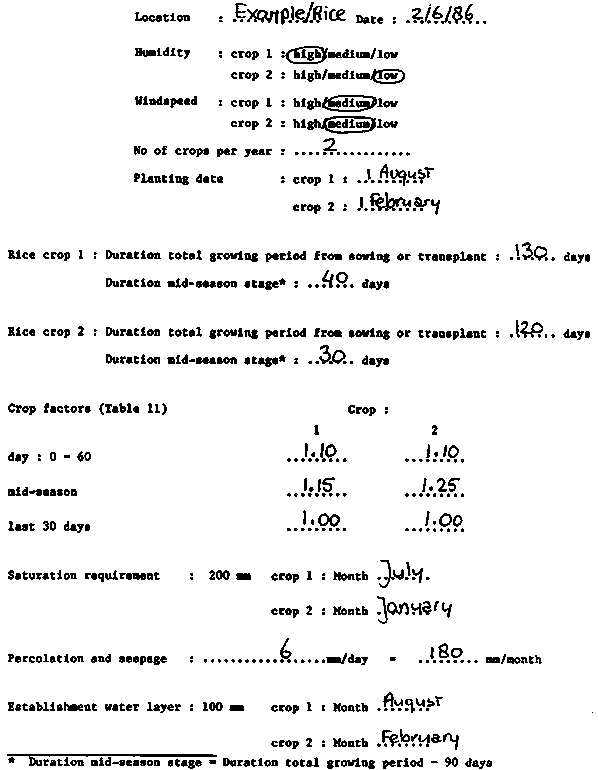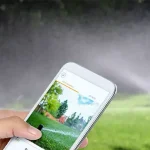Are you struggling to figure out how much water your crops actually need? You’re not alone.
Understanding the water requirements of different crops can be a game-changer for your agricultural success. Water is a vital resource for healthy plant growth, and too much or too little can make or break your harvest. In this guide, you’ll discover easy-to-follow methods to calculate water needs for various crops.
We’ll dive into practical tips and strategies that can help you optimize your water usage, ensuring your plants thrive while conserving this precious resource. Read on to unlock the secrets of efficient water management and take your farming skills to the next level!

Factors Influencing Water Needs
Understanding water needs for crops is crucial for optimal growth. Different factors influence how much water each crop requires. These factors vary widely, affecting water management strategies significantly. Knowing them helps farmers make informed decisions and conserve resources.
Climate Conditions
Climate plays a key role in crop water needs. Hot climates increase evaporation rates, leading to higher water requirements. Cool climates reduce evaporation, lowering water demand. Rainfall patterns also impact water needs significantly. Areas with frequent rain may need less irrigation. Dry regions require more water for crops.
Soil Type
Soil type affects water absorption and retention. Sandy soil drains quickly, requiring more frequent watering. Clay soil holds water longer, reducing irrigation frequency. Loamy soil offers balanced drainage and retention. Knowing soil type helps in planning efficient watering schedules.
Crop Type
Different crops have varied water needs. Some crops, like rice, need flooded fields. Others, like cacti, thrive in dry conditions. Understanding the specific needs of each crop ensures healthy growth. Crop type influences how much water is required daily.
Growth Stage
Crops need varying water amounts at different growth stages. Seedlings often require more water for establishment. Mature plants may need less frequent watering. Flowering and fruiting stages often demand increased water. Monitoring growth stages helps optimize irrigation practices.
Root Depth
Root depth determines how plants access water. Shallow roots need frequent watering. Deep roots can reach water stored in soil. Understanding root depth aids in effective irrigation planning. It helps in maintaining soil moisture at appropriate levels.

Methods To Determine Crop Water Requirements
Calculating crop water needs involves assessing soil moisture, climate, and crop type. Tools like evapotranspiration rates and soil sensors help determine precise water requirements. Understanding these factors ensures optimal irrigation, boosting crop health and yield.
Understanding how to calculate water needs for different crops is crucial for any farmer or gardener. Water is a precious resource, and using it wisely can lead to healthier plants and better yields. But how do you determine exactly how much water each crop requires? The answer lies in a few tried-and-tested methods that can guide you in making informed decisions for your crops.1. Penman-monteith Equation
The Penman-Monteith equation is a widely recognized method to calculate crop water needs. It considers factors like temperature, humidity, wind speed, and solar radiation. This method might sound technical, but there are online calculators that make it easier for you to use. Imagine you’re growing tomatoes in a warm climate. This equation can help you decide if your watering schedule is sufficient based on the weather conditions.2. Crop Coefficient Method
The crop coefficient method is another practical approach. It involves multiplying the reference evapotranspiration (ET0) by a crop-specific coefficient (Kc). Each crop has a unique Kc value that changes with growth stages. For instance, corn might need more water during its flowering stage than during its initial growth. Are you keeping track of your crop’s growth stages? This method could help you adjust your watering habits to match the crop’s changing needs.3. Soil Moisture Sensors
Technology can be your ally with soil moisture sensors. These devices measure the moisture content in the soil and provide real-time data. They can help you avoid overwatering or underwatering. You can install a sensor in your vegetable garden and receive alerts when the soil moisture drops below the ideal level. This method offers a direct insight into your soil’s condition, allowing you to make timely adjustments.4. Water Balance Approach
The water balance approach considers all water inputs and outputs in a crop field. It includes rainfall, irrigation, evapotranspiration, and drainage. This holistic view helps you understand the overall water dynamics in your field. Imagine tracking a balance sheet where water is both a credit and debit. Are you aware of how much water your crops truly use versus what you add?5. Empirical Observations And Adjustments
Sometimes, the best method involves your own observations and adjustments. Watch how your crops respond to watering and adjust accordingly. Take note of signs like wilting or yellowing leaves. Have you ever noticed your plants looking droopy in the afternoon despite morning watering? That might be a sign to tweak your watering schedule. Your keen observations can be just as valuable as any scientific method. By exploring these methods, you can make more informed decisions about watering your crops. Whether you’re using equations, technology, or your own observations, understanding your crop’s water needs is a key step towards sustainable farming. How will you choose to assess your crop’s needs?Tools And Technologies For Water Management
Understanding water needs for crops involves using tools like soil moisture sensors and weather data. These technologies help farmers determine the right amount of water for each crop. This ensures crops get enough water without waste.
Water management is crucial for successful agriculture. It ensures that crops receive the right amount of water, improving yields and conserving resources. With advancements in technology, there are several tools available to help you calculate and manage water needs efficiently. These tools provide precise data, making it easier to make informed decisions about water usage.Weather Stations
Weather stations are a game-changer in water management. They provide real-time data on temperature, humidity, rainfall, and wind speed. With this information, you can anticipate the water needs of your crops and adjust your irrigation schedule accordingly. Imagine knowing exactly when rain is on the way and reducing your water usage in anticipation. This can save both water and money, and prevent overwatering your crops.Soil Moisture Sensors
Soil moisture sensors give you direct insight into the water content of your soil. These sensors can be placed at various depths to measure moisture levels accurately. By understanding the moisture status of your soil, you can decide when and how much to water. This technology can prevent the common mistake of watering based on a fixed schedule rather than actual need. It also helps avoid water wastage and ensures your crops get the right amount of water.Smart Irrigation Systems
Smart irrigation systems take automation to the next level. By connecting to weather stations and soil moisture sensors, these systems can automatically adjust watering schedules. This means you can manage your irrigation remotely through a smartphone or computer. It’s like having a personal assistant dedicated to keeping your crops healthy. Smart systems help reduce water use and ensure crops are watered at optimal times.Mobile Apps For Water Management
Mobile apps make water management accessible and convenient. With these apps, you can monitor weather forecasts, soil moisture levels, and even control irrigation systems. They provide alerts and recommendations based on real-time data, making it easier to manage water use effectively. Are you making the most of technology to manage your water resources? With the right app, you can have all the information you need at your fingertips.Remote Sensing Technology
Remote sensing technology uses satellites and drones to gather data about your fields. It provides detailed information about crop health, soil moisture, and water stress. This bird’s-eye view can help you identify areas that need more or less water. Remote sensing allows you to manage large fields efficiently by pinpointing specific areas that require attention. Are you taking advantage of this technology to enhance your water management strategies? Embracing these tools and technologies can transform how you manage water for your crops. By using precise data, you can optimize irrigation, conserve resources, and ensure your crops thrive. Are you ready to integrate these technologies into your farming practices? The right tools can make all the difference.Tips For Efficient Water Use In Agriculture
Determining water needs for crops is crucial in agriculture. Calculate based on crop type, soil, and climate. Efficient water use involves understanding these variables to ensure optimal growth and resource conservation.
Efficient water use in agriculture is crucial for sustainable farming. With growing concerns about water scarcity, understanding how to use water wisely can make a significant difference. Not only does this practice help conserve resources, but it also improves crop yield and quality. Let’s dive into some practical tips that can help you manage water more effectively on your farm.Understand Your Crop’s Specific Water Needs
Different crops have different water requirements. Knowing how much water your plants need at various stages of growth is essential. This knowledge helps you avoid over-watering or under-watering, both of which can harm plant health and reduce yields.Utilize Drip Irrigation Systems
Drip irrigation is a smart way to deliver water directly to the plant roots. This system minimizes evaporation and runoff, ensuring that water reaches where it’s needed most. Consider installing a drip system to cut down on water waste and improve efficiency.Monitor Soil Moisture Levels
Keeping an eye on soil moisture can prevent unnecessary watering. Use soil moisture sensors to get accurate readings. This technology helps you decide when to water, optimizing water use and preventing plant stress.Implement Rainwater Harvesting
Collecting rainwater can be a great supplemental water source. Setting up a rainwater harvesting system can reduce your dependency on other water supplies. It’s an eco-friendly approach that can lead to significant savings over time.Schedule Watering At Optimal Times
Watering during cooler parts of the day, such as early morning or late afternoon, reduces evaporation. This practice ensures more water reaches the plant roots. Adjust your watering schedule to take advantage of these optimal times for better results.Maintain Healthy Soil
Healthy soil retains moisture better. Incorporate organic matter like compost to improve soil structure and water-holding capacity. Healthy soil not only supports plant growth but also reduces the need for frequent watering.Consider Crop Rotation And Diversity
Crop rotation and diversity can improve soil health and water retention. By rotating crops, you can break pest cycles and enhance soil nutrients. Diverse planting can also create a microclimate that reduces water loss. How do you ensure you’re not wasting this precious resource on your farm? Employing these methods not only saves water but boosts your overall agricultural productivity.
Conclusion
Calculating water needs for crops is essential for healthy growth. Start by understanding each plant’s specific requirements. Consider soil type and weather conditions. Use tools to measure soil moisture levels. Adjust irrigation based on plant growth stages. Regular monitoring prevents overwatering or underwatering.
This helps conserve water and supports sustainable farming. Keep learning and adapting your methods. Every crop is unique, so stay attentive. Your efforts lead to a thriving garden or farm. Happy planting!


